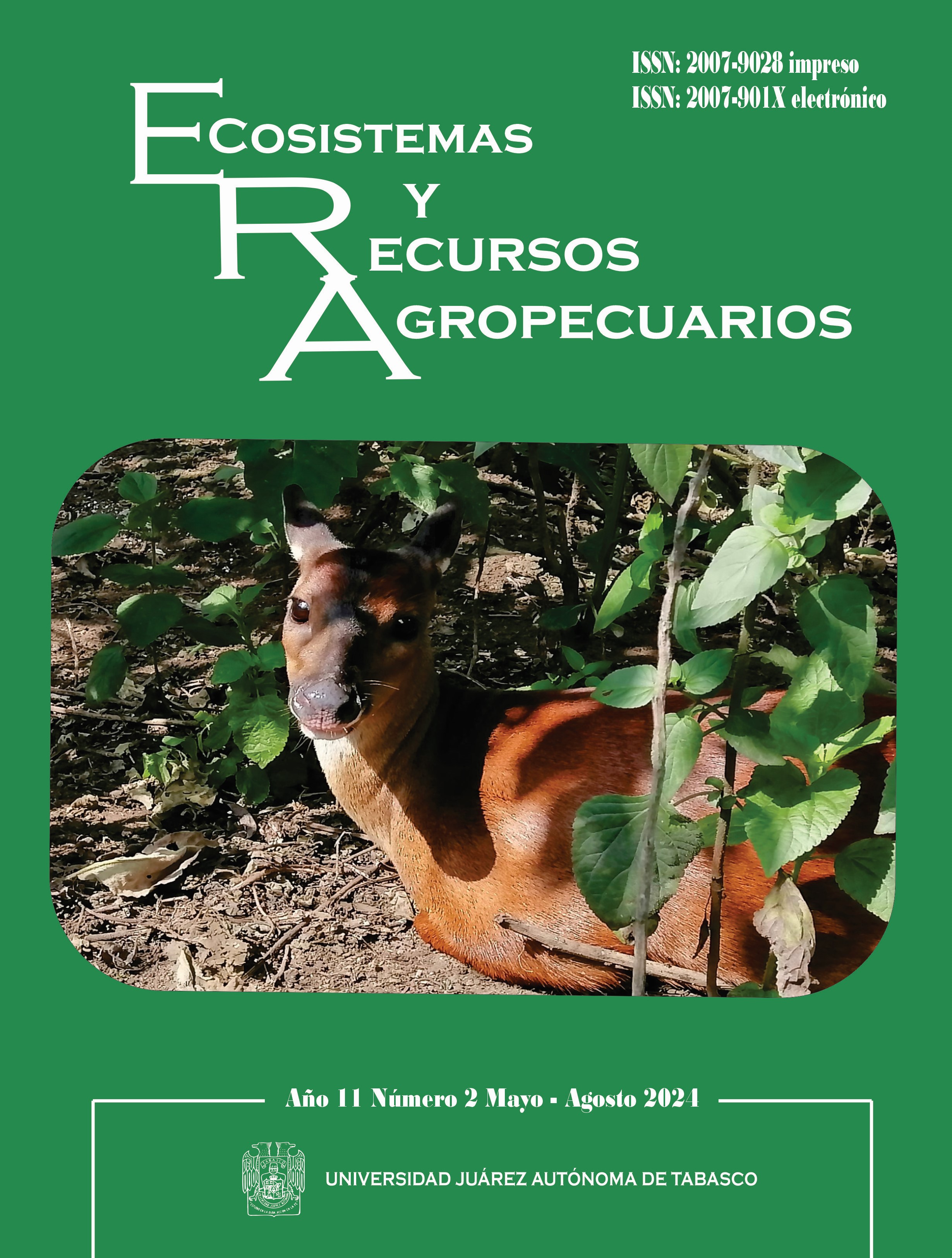Anatomía de hojas de pasto salado (Distichlis spicata L.) con riego y sin riego
DOI:
https://doi.org/10.19136/era.a11n2.3582Palabras clave:
estructuras de estomas, Halófitas, gramíneasResumen
Distichlis spicata es una especie de gramínea halófita que crece en las zonas costeras. El objetivo del estudio fue identificar las modificaciones en la estructura anatómica de estomas de la epidermis foliar de D. spicata, cultivadas con riego y sin riego. Se seleccionaron dos poblaciones, 1) plantas de D. spicata con riego y 2) plantas de D. spicata sin riego. De cada población se seleccionaron 10 plantas por repetición y de cada planta seleccionada se tomó la cuarta hoja. Cada hoja se cortó longitudinalmente en cuatro segmentos que se secaron y analizaron utilizando un microscopio electrónico de barrido. Las variables medidas fueron la densidad estomática, largo y ancho de estomas y poros, el área estomática, la proporción del área de poros con respecto al tamaño de los estomas y la proporción de estomas por superficie. Los resultados mostraron que la población de D. spicata con riego y sin riego mostraron modificaciones anatómicas en la estructura de los estomas en la epidermis adaxial pero no en la epidermis abaxial. En la epidermis adaxial, las plantas con riego presentaron valores más altos de longitud de estoma, ancho de estoma, área de estoma y longitud de poro, mientras que las plantas sin riego mostraron valores más altos de proporción poro/estoma y densidad estomática. Las plantas de D. spicata sin riego presentaron estomas más pequeños respecto a las plantas con riego; además, las plantas sin riego incrementaron la acumulación de cristales de sal en la epidermis abaxial.
Descargas
Referencias
Agüero-Fernández YM, Hernández-Montiel LG, Murillo-Amador B, Nieto-Garibay A, Troyo-Diéguez E, Zulueta-Rodríguez R, Ojeda-Silvera CM (2018) Arbuscular mycorrhizal fungi alleviate salt stress on sweet (Ocimum basilicum L.) seedlings. Tropical and Subtropical Agroecosystems 21(3): 387-398.
Aguilera, C.M, & Martínez, R (1996). Relaciones Agua. Suelo, Planta, Atmósfera. Universidad Autónoma Chapingo, México, 256-256.
Al-Shamsi N, Hussain MI, El-Keblawy A (2020) Physiological responses of the xerohalophyte Suaeda vermiculata to salinity in its hyper-arid environment. Flora 273: 151705. https://doi.org/10.1016/j.flora.2020.151705
Apóstolo NM (2005) Caracteres anatómicos de la vegetación costera del Río Salado (Noroeste de la provincia de Buenos Aires, Argentina). Boletín de la Sociedad Argentina de Botánica 40: 215-227.
Arruda RCO, Viglio NSF, Barros AAM (2009) Leaf anatomy of halophytes and psammophilous plants from the Restinga of Ipitangas, Saquarema, Rio de Janeiro, Brazil. Rodriguésia 60: 333-352. https://doi.org/10.1590/2175-7860200960207
Bell HL (2010) A new species of distichlis (Poaceae, Chloridoideae) from Baja California, Mexico. Madroño 57: 54-63. https://doi.org/10.3120/0024-9637-57.1.54
Boeger MRT, Gluzezak RM (2006) Structural adaptations of seven plant species to the environmental conditions of sand dunes in Santa Catarina, Brazil. Iheringia-Serie Botanica 61: 73-82.
Boer MM, De Dios VR, Stefaniak EZ, Bradstock RA (2021) A hydroclimatic model for the distribution of fire on earth. Environmental Research Communications 3(3): 035001. https://doi.org/10.1088/2515-7620/abec1f
Céccoli G, Ramos J, Pilatti V, Dellaferrera I, Tivano JC, Taleisnik E, Vegetti AC (2015) Salt glands in the Poaceae family and their relationship to salinity tolerance. Botanical Review 81: 162-178. https://doi.org/10.1007/s12229-015-9153-7
Da Silva BO, Victório CP, Arruda R do C de O (2020) Anatomical and micromorphological traits in leaf blade of halophytes from a brazilian sandy coastal plain. In: Grigore MN (ed) Handbook of Halophytes. Springer, Cham. pp. 933-962. https://doi.org/10.1007/978-3-030-57635-6_30
Drake PL, Froend RH, Franks PJ (2013) Smaller, faster stomata: Scaling of stomatal size, rate of response, and stomatal conductance. Journal of Experimental Botany 64: 495-505. https://doi.org/10.1093/jxb/ers347
Evert RF (2008) Esau. Anatomía Vegetal. Meristemas, células y tejidos de las plantas: Su estructura, función y desarrollo. 3rd edition ed. Omega, Barcelona, España. 614p.
Faraday CD, Thomson WW (1986) Structural aspects of the salt glands of the plumbaginaceae. Journal of Experimental Botany 37: 461-470. https://doi.org/10.1093/jxb/37.4.461
Fraser LH, Greenall A, Carlyle C, Turkington R, Friedman CR (2009) Adaptive phenotypic plasticity of Pseudoroegneria spicata: response of stomatal density, leaf area and biomass to changes in water supply and increased temperature. Annals of Botany 103: 769-775. https://doi.org/10.1093/aob/mcn252
Frías-Ureña HG, Ruiz-Corral JA, Macías-Rodríguez MÁ, Durán N, González D, De Albuquerque F, Torres-Morán JP (2022) Relationship between the distribution of vegetation and the environment in the coastal embryo dunes of Jalisco, México. PeerJ 10: e13015. DOI:10.7717/peerj.13015
García E (2004) Modificaciones al sistema de clasificación climática de Köppen. Instituto de Geografía de la Universidad Nacional Autónoma de México. Ciudad de México. 97p.
García M, Jáuregui D, Medina E (2008) Adaptaciones anatómicas foliares en especies de angiospermas que crecen en la zona costera del Estado Falcón (Venezuela). Acta Botanica Venezuelica 31: 291-306.
He H, Veneklaas EJ, Kuo J, Lambers H (2014) Physiological and ecological significance of biomineralization in plants. Trends in Plant Science 19: 166-174. https://doi.org/10.1016/j.tplants.2013.11.002
INEGI, Instituto Nacional de Estadística y Geografía (2017) Anuario Estadístico y Geográfico de los Estados Unidos Mexicanos. https://www.inegi.org.mx/. Date accessed: 13 February 2022.
Jáuregui D, Castro M, Ruíz-Zapata T, Lapp M (2014) Anatomía de los órganos vegetativos de dos especies de Atriplex (Chenopodiaceae) que crecen en Venezuela. Revista de Biología Tropical 62: 1625-1636.
Kobayashi H (2008) Ion secretion via salt glands in Poaceae. Japanese Journal of Plant Science 2: 1-8.
Kuster VC, Da Silva LC, Meira RMSA (2020) Anatomical and histochemical evidence of leaf salt glands in Jacquinia armillaris Jacq. (Primulaceae). Flora 262: 151493. https://doi.org/10.1016/j.flora.2019.151493
Kuster VC, Campos Da Silva LC, Alves Meira RMS, Alves Azevedo R (2016) Glandular trichomes and laticifers in leaves of Ipomoea pes-caprae and I. imperati (Convolvulaceae) from coastal Restinga formation: structure and histochemistry. Brazilian Journal of Botany 39: 1117-1125. https://doi.org/10.1007/s40415-016-0308-5
Lazarus BE, Richards JH, Gordon PE, Oki LR, Barnes CS (2011) Plasticity tradeoffs in salt tolerance mechanisms among desert Distichlis spicata genotypes. Functional Plant Biology 38: 187-198. https://doi.org/10.1071/FP10192
León de la Luz JJ, Fanjul L (1983) Densidad estomática en plantas masculinas y femeninas de jojoba (Simmondsia chinensis Link) Chneider) procedentes de la costa de Sonora, México. Biotica 8: 303-307.
León de La Luz JL, Rebman JP, Van Devender TR, Sánchez-Escalante JJ, Delgadillo-Rodríguez J, Medel-Narváez, A (2018) El conocimiento florístico actual del Noroeste de México: Desarrollo, recuento y análisis del endemismo. Botanical Sciences 96: 555-568. https://doi.org/10.17129/botsci.1885.
Madewell M, Feagin R, Huff T, Balboa B (2022) High times and dry times in a salt marsh: budgeting for supplemental freshwater needs at the big boggy national wildlife refuge, USA. Research Square. 1-24. https://doi.org/10.21203/rs.3.rs-1178631/v1
Maricle BR, Cobos DR, Campbell CS (2007) Biophysical and morphological leaf adaptations to drought and salinity in salt marsh grasses. Environmental and Experimental Botany 60:458-467. https://doi.org/10.1016/j.envexpbot.2007.01.001
Maricle BR, Maricle KL (2018) Photosynthesis, stomatal responses, and water potential in three species in an inland salt marsh in Kansas, USA. Flora 244-245: 1-7. https://doi.org/10.1016/j.flora.2018.05.001
Massey FJ (1951) The Kolmogorov-Smirnov test for goodness of fit. Journal of the American Statistical Association 46: 68-78. DOI:10.1080/01621459.1951.10500769
Mata-González R, Hovland M, Abdallah MAB, Martin DW, Noller JS (2021) Nutrient uptake and gas exchange of Great Basin plants provide insight into drought adaptations and coexistence. Journal of Plant Ecology 14: 854-869. https://doi.org/10.1093/jpe/rtab037
Morris C, Morris LR, Monaco TA (2019) Evaluating the effectiveness of low soil-disturbance treatments for improving native plant establishment in stable crested wheatgrass stands. Rangeland Ecology and Management 72: 237-248. https://doi.org/10.1016/j.rama.2018.10.009
Norman HC, Masters DG, Barrett-Lennard EG (2013) Halophytes as forages in saline landscapes: Interactions between plant genotype and environment change their feeding value to ruminants. Environmental and Experimental Botany 92: 96-109. https://doi.org/10.1016/j.envexpbot.2012.07.003
Paradiso R, Arena C, De Micco V, Giordano M, Aronne G, De Pascale S (2017) Changes in leaf anatomical traits enhanced photosynthetic activity of soybean grown in hydroponics with plant growth-promoting microorganisms. Frontiers in Plant Science 8: Article 674. https://doi.org/10.3389/fpls.2017.00674
Rojas-Oropeza M, Fernández FJ, Caudan C, Cabirol N (2022) Anammox microbial activity in sodium saline soil of former Lake Texcoco, Mexico. Revista Internacional de Contaminacion Ambiental 38: 27-35. https://doi.org/10.20937/rica.54088
Semenova GA, Fomina IR, Biel KY (2010) Structural features of the salt glands of the leaf of Distichlis spicata ‘Yensen 4a’ (Poaceae). Protoplasma 240(1). https://doi.org/10.1007/s00709-009-0092-1
Soreng RJ, Peterson PM, Davidse G, Judziewicz EJ, Zuloaga FO, Filgueiras TS, Morrone O (2003) Catalogue of new world grasses (Poaceae): IV. Subfamily Pooideae. Contributions from the United States National Herbarium 48: 1-730. 2003_Deschampsia_Chiapella___al_-libre.pdf (d1wqtxts1xzle7.cloudfront.net) Data: accessed: 12 October 2022)
Wilkinson HP (1979) The plant surface (mainly leaf). In: Metcalfe CR, Chalk L (eds). Anatomy of the dicotyledons, 2nd edition. Clarendon Press. New York. pp. 97-165.
Zucol AF, Patterer NI, Moya E, Fernández-Pepi MG (2019) Phytolith analysis of the main species of Distichlis sp. (Chloridoideae: Poaceae) distributed in South America. Review of Palaeobotany and Palynology 269: 42-54. https://doi.org/10.1016/j.revpalbo.2019.06.004
Descargas
Publicado
Número
Sección
Licencia
Derechos de autor 2024 Ecosistemas y Recursos Agropecuarios

Esta obra está bajo una licencia internacional Creative Commons Atribución-NoComercial-CompartirIgual 4.0.
1. Política propuesta para revistas de acceso abierto
Los autores/as que publiquen en esta revista aceptan las siguientes condiciones:
1. Los autores/as conservan los derechos de autor y ceden a la revista el derecho de la primera publicación, con el trabajo registrado con la Licencia CC BY-NC-ND 4.0 Creative Commons Attribution-NonCommercial-NoDerivatives 4.0 Internacional de Creative Commons, que permite a terceros utilizar lo publicado siempre que mencionen la autoría del trabajo y a la primera publicación en esta revista.
2. Los autores/as pueden realizar otros acuerdos contractuales independientes y adicionales para la distribución no exclusiva de la versión del artículo publicado en esta revista (p. ej., incluirlo en un repositorio institucional o publicarlo en un libro) siempre que indiquen claramente que el trabajo se publicó por primera vez en esta revista.
3. Se permite y recomienda a los autores/as a publicar su trabajo en Internet (por ejemplo en páginas institucionales o personales) antes y durante el proceso de revisión y publicación, ya que puede conducir a intercambios productivos y a una mayor y más rápida difusión del trabajo publicado (vea The Effect of Open Access).
![]()
This work is licensed under CC BY-NC-ND 4.0


